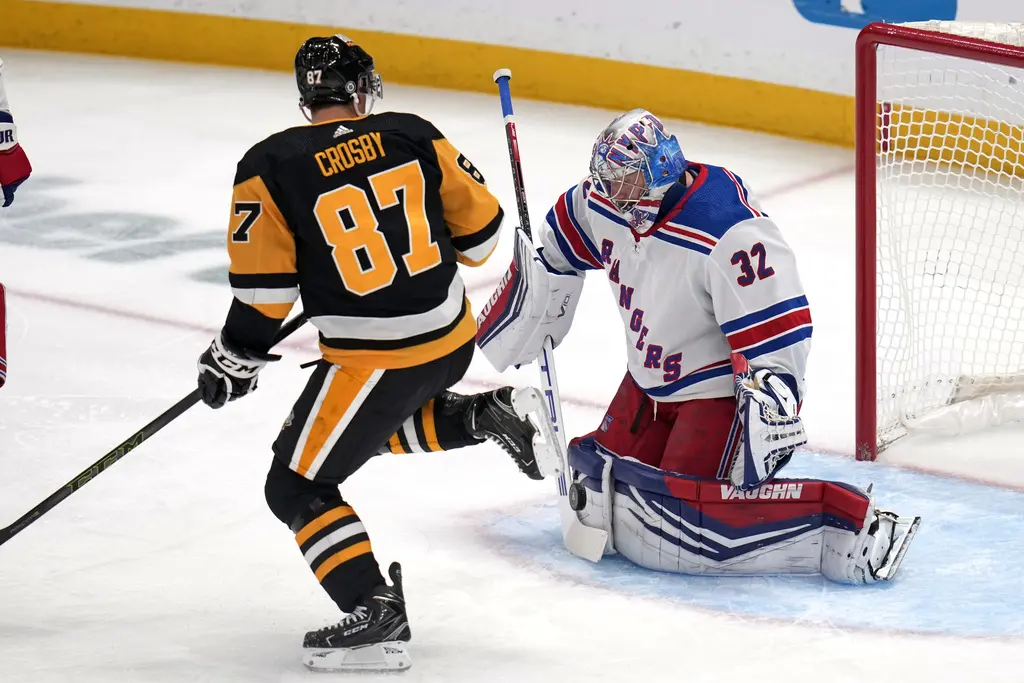NHL Playoffs
4 Big Lessons Penguins Can Learn from Conference Finals

It now seems a lifetime ago that the Pittsburgh Penguins’ season ended with a meaningless game on Long Island and Jeff Carter’s surprise postgame retirement. After a furious late run to make the playoffs that fell short, the Penguins packed up that night, knowing there would be no games ahead. However, as president of hockey operations/GM Kyle Dubas works through offseason plans and changes, the four teams still playing can teach the Penguins a few important lessons.
And yes, a prime lesson will come from their rivals, the New York Rangers.
The candy and nuts of the ifs and buts of the Penguins season most assuredly include special teams. Specifically, it is legal to score when the other team takes a penalty. In fact, not only is it legal to score, but it’s also strongly encouraged to prevent the team playing shorthanded from scoring.
For all of the Penguins faults in the 2023-24 NHL season, the power play could have saved them. Instead, it was a deflated life raft that kept the team aimlessly adrift.
Lesson #1: Special Teams Matter
The New York Rangers find a way to claw back into games, rev their home crowd, and put unnatural pressure on opponents despite relatively below-average 5v5 play.
The Edmonton Oilers’ power play strikes fear into the hearts of coaches and penalty killers. Before the Vegas Golden Knights tried a few daring strategies to slow down the Edmonton power play in 2023 Round Two, Edmonton’s man advantage was clicking above 50%. In this year’s run to the Western Conference Final, Edmonton is at nearly 35%.
Power play goals cure a lot of ills and camouflage others.
It defies traditional wisdom, but New York and Edmonton’s power play success is among the primary reasons they are still playing. In the regular season, New York had the third-ranked power play (26.4%), and Edmonton was fourth (26.3%). In the playoffs, Edmonton is second, New York is fourth (26.8%), and New York seems to convert every important opportunity.
Shorthanded goals against are not a problem, either.
The Penguins’ power play was among the worst in the NHL this season and was no better than mid-pack last season. This season, the Penguins finished 30th at 15.3%, a truly abysmal number considering the world-class talent that inhabited the 200-foot sheet of ice. It cost associate coach Todd Reirden his job, and it surely warmed coach Mike Sullivan’s seat, too.
Lesson #2: Maximize Talent
Dallas and Edmonton are examples of loading up the top six with the best players and getting production. Dallas signed Matt Duchene last summer after the Nashville Predators exorcised a buyout. Rather than space out the talent, coach Pete DeBoer packed his top two lines with a few centers, moving Tyler Seguin to the wing beside Duchene.
In fact, DeBoer is one of the early adopters of “positionless hockey,” which involves having at least two players on every line who can interchange as wingers or centers.
Edmonton has the luxury of putting Leon Draisaitl with Connor McDavid or slotting him as the second-line center. The pair are sure to create offense when together, but it’s a move that Sullivan has been reluctant to use often with Sidney Crosby and Evgeni Malkin.
Keeping the generational talents apart certainly didn’t add balance this season, as Crosby and his line largely carried the team for much of the season.
It’s not a move to rely on, but it could be used more often for games or weeks when the roster seems to have gone cold.
Lesson #3: Draft, Draft, and Draft Well
Credit Philly Hockey Now colleague Jon Bailey for this one.
Earlier in the week, TSN did an in-depth review of the Dallas Stars’ drafting prowess (but removed the video from their website). They have found talent throughout the draft and later in the first round, including Wyatt Johnston, who was selected 23rd overall in the 2021 NHL Draft.
Dallas’s lineup is chock-full of draft-pick goodness from the last seven years: Jason Robertson (second round, 2017), Logan Stankoven (second round, 2021), Ty Dellandrea (13th overall, 2018), Thomas Harley (18th overall, 2019), Miro Heiskanen (third overall, 2017), and goalie Jake Oettinger (26th overall, 2017).
Contrast that lineup with the whopping one draft pick in the last decade who is currently in the Penguins lineup: Valtteri Puustinen (seventh round, 2019).
Perhaps the Penguins have a few on the way, with Joel Blomqvist (second round, 2020) and Tristan Broz (second round, 2021), but it’s hard to argue the Penguins’ fervent strategy of trading draft picks for talent has benefitted them since 2017.
Lesson 4: Toughness
Is anyone tougher than the Florida Panthers? We thought the Rangers had a good bit of grit, but the Panthers are physically punishing them. In fact, Florida punishes everyone.
Dallas is no slouch, either.
Three of the four remaining teams are generally tough to play against, not because of suffocating defensive structures but because of their ability to exert brute force to complement ample skill.
Bonus: No.1 goalies matter
For a few years, hockey chatter has been centered on tandems and paying lesser goalies fewer coins rather than searching for a bedrock goaltender. There’s no doubt that Florida’s Sergei Bobrovsky, New York’s Igor Shesterkin, and Oettinger are some of the best in the game.
Perhaps the lesson should be tandem when you must, but look for “the guy.”
Which one is the Penguins’ Tristan Jarry?











